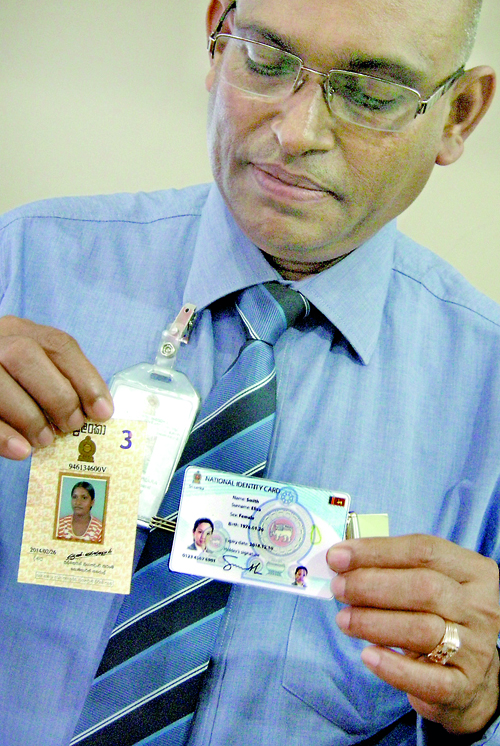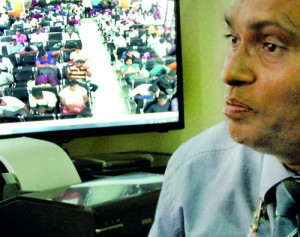News
Fingerprint collection to begin for eNICs
The Department of Registration of Persons (the identity card office) is to start collecting fingerprints this year to issue 16.5 million electronic identity cards (eNICs) in 2016 that will include biometric security features such as fingerprints and bar codes.
Fingerprints will be collected manually at 331 district and divisional level units and scanned and entered into a national register.
The department set up a National Register of Persons on February 28 with over 800 officials recruited to input data in order to begin issuing eNICs in two years.

Mr. Kumara holds up an old NIC and one with computerised features which he says is the steppingstone to the eNIC. Pix by Athula Devapriya
In the meantime, NICs are to be issued with computerised input replacing handwriting. Names will be stated in both Sinhala and Tamil, and instead of a pasted photo ID cards issued this year will include a scanned photo as well as the scanned signature of the Commissioner-General of the Department.
“This is the stepping stone to the eNIC,” said Commissioner-General R.M.S. Sarath Kumara. “This year’s NIC will have the same features as the old NIC but with several computerised features. This will help the public as well as employees at the department to gradually get used to a smart NIC system.”
In an interview with The Sunday Times, Mr. Kumara said that the department issued its first identity card in 1972, and until 2007 card details were entered manually as well as recorded in books.
“There was an automated system till last month but it was not a national database: it was only to trace the application saved in about 1500 books. This system was mainly to track down the name and address by entering the index number. This was not a proper system as there were inadequate inputs that led to officers searching old files and records,” he said.
As there was only manual record-keeping, police and the Criminal Investigation Department investigating forgeries have had to visit the department to track information.
The manual ID card is easy to forge and is subject to human error.
“There are several persons with the same NIC number. Some officers had clear handwriting while some others did not have. Some IDs did not have the names correctly. There were issues regarding gender. There was also the issue of language as the previous IDs were only in Sinhala.
“Most people did not bother to correct their IDs and just ignored errors as obtaining an ID is a tedious process of obtaining certification from grama niladharis to divisional secretariats and then to the issuing of the card from the department,” Mr. Kumara said.
About 500-750 persons come daily to the department headquarters in Jawatte, Colombo 5 to collect their NICs, sometimes having to wait until 7.00-8.00pm. To get corrections to NICs, people spend hours in queues at the district/divisional secretariat offices.

Waiting for a new NICs: Crowds on Friday at The Department of Registration of Persons
The National Database and Registration Authority (NADRA) in Pakistan and Informatics here will be involved in developing the eNIC.
NADRA has experience in designing and delivering smart national identity cards, drivers’ licences and refugee biometric registration projects in countries such as Kenya, Nigeria and Bangladesh and for organisations such as the UNHCR, and will be involved in scanning, maintaining a data centre, digitalising new ID forms etc.
The Commissioner-General said arrangements were being made to amend the Registration of Persons Act to include the technological advancements.
“The Act mainly emphasises a person’s eligibility to receive the NIC. Some people have the ‘X’ version of the NIC. This states that they are not eligible to vote. Such cards are issued to those who had received an NIC before reaching voting age. People working on the estates and Chinese nationals who settled here being awarded citizenship also received these cards. There is a need to have one NIC for all Sri Lankans. This should be clear in the Act as well,” he said.
The department was in the process of identifying weaknesses in the existing system and by 2016 all officers in the department would be well-trained to issue eNICs to all citizens above the age of 15.
“A majority of the officers working here are in need of computer training, especially in the field of data-entering, scanning and general computer use,” said Mr. Kumara. “There is also a need of an attitude change towards digitalisation of the system. The changes have been delayed for almost a decade due to this.”
Authorities are struggling with the lack of translators from Sinhala to Tamil since the inception of bilingual ID cards from this year.
“The system is in English and therefore details need to be checked by translators. There is a need for another 70 translators,” Mr. Kumara added.


